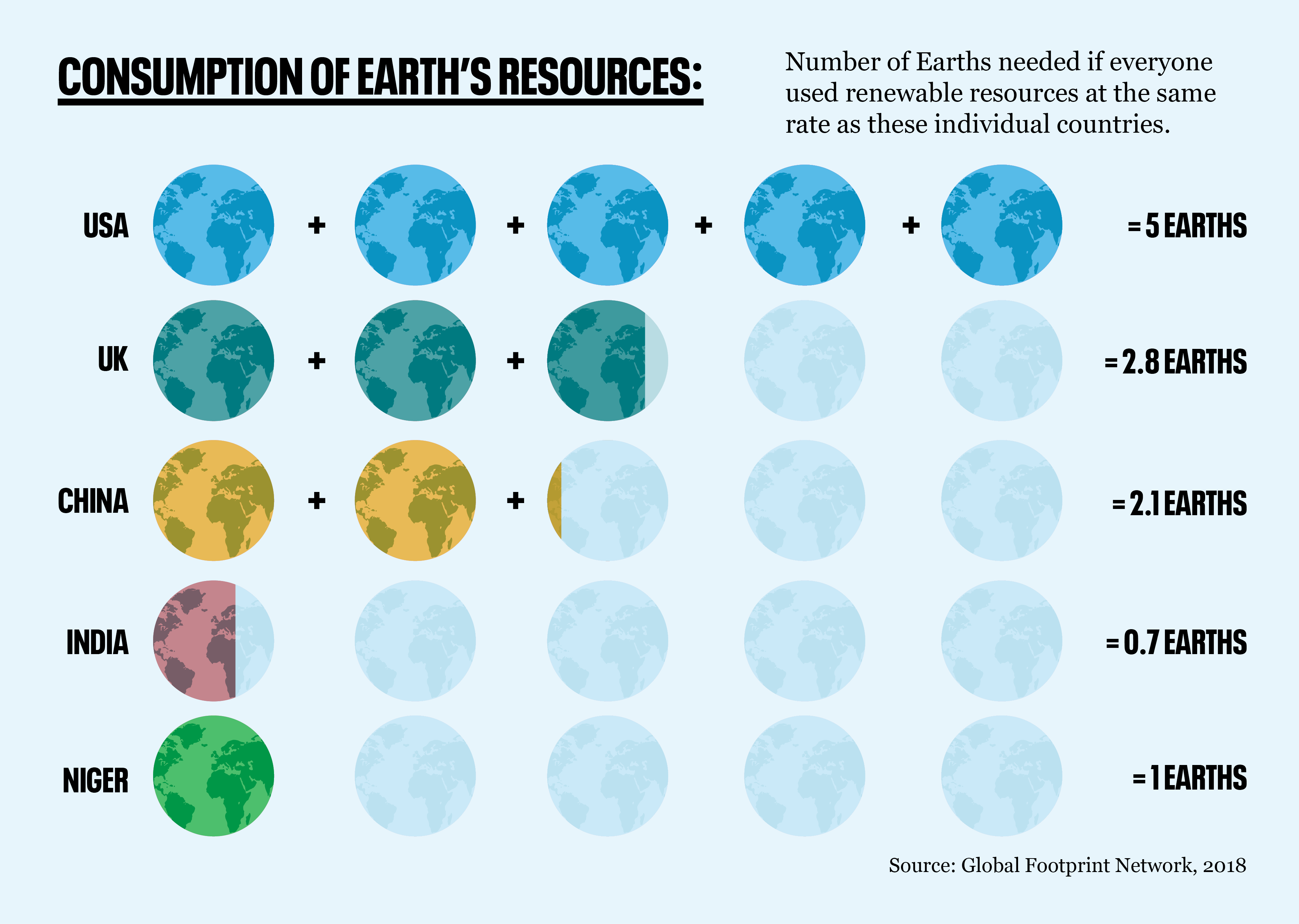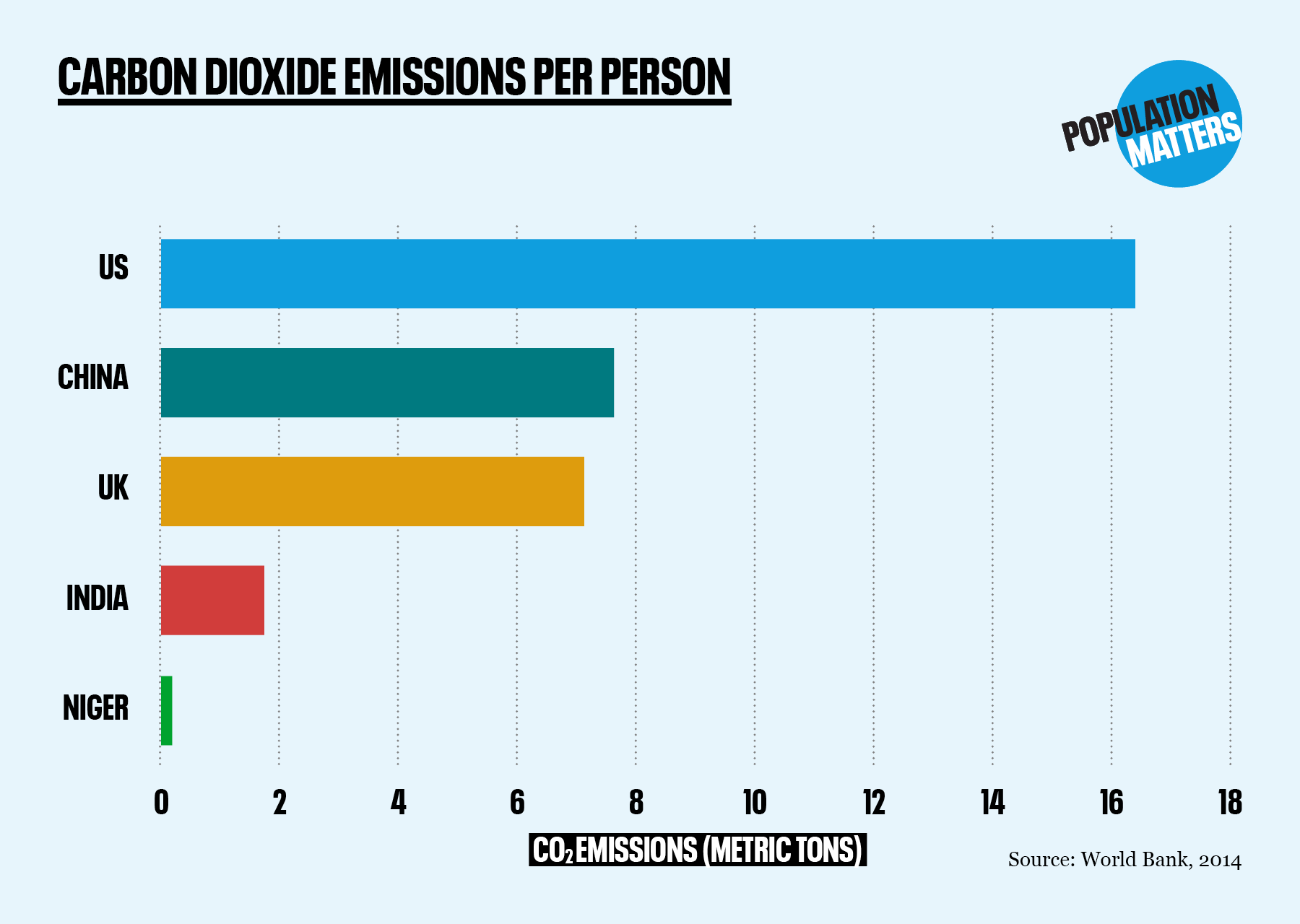
Can we shrink our energy footprint?
A new study suggests we can reduce global energy consumption by 75% and still lead comfortable lives. Our Head of Campaigns, Alistair Currie, asks – can we do it?
The UN projects that our current population of 7.8bn will grow to 9.7bn by 2050, and go on to reach nearly 11bn by the end of the century. Each of those new people will require housing, infrastructure, food, water and energy. Population growth is far from the only factor driving demand, however.
In the world today, it has been calculated that about one person escapes extreme poverty every second; five people a second are entering the so-called “global middle class” of people living in relative comfort and security; and every two seconds someone becomes “rich”, by global standards. It is estimated that the global middle class will reach more than 5bn people by 2050
This is essential and welcome for the poorest, but increasing affluence is a critical driver of our environmental crisis. Is it possible for everyone to be comfortable, without breaking the planet we live on?
Going back to the Summer of Love
The new study, published in Global Environmental Challenge, works on the “bottom up” principle of determining what the energy requirements would be for an assumed 10bn people, all living lives of physical comfort and security, but without luxuries – households have laptops, heating and washing machines but not all owning cars, or, in the researchers’ words, having “plates piled high with red meat seven days a week”.
The research calculates that those needs could be met by roughly the same level of global energy consumption as in the 1960s (when the population was less than half what it is today). That is 60% less energy than we currently consume – and just a quarter of currently projected energy consumption for 2050.
The authors note that this level of energy demand is only slightly higher than current projections suggest non-fossil fuel sources will be able to provide by 2050.
Radical action
Can such a transition be achieved? The researchers believe it can, through two routes – the comprehensive and urgent development and use of new technology, and the equally urgent and comprehensive flattening out of the grotesque inequalities which exist globally. In an associated article, one of the study’s authors describes this as “radical action on all fronts”
The scale of this enterprise is huge. For instance, in order to realise the benefits of new technology and design, the study assumes that all housing and public buildings such as schools and hospitals are replaced with energy-efficient stock by 2050, a scenario which appears at present highly unlikely. In regard to transport, it combines an “ambitious” vision for the use of public transportation with the assumption that current projections of the maximum energy efficiency of vehicles are met (the authors note that this assumes all the associated cost and other obstacles are overcome).
Floors and ceilings
Socially, the transformation is no less radical. Currently, the energy consumption of the lowest-consuming half of the global population is calculated to be less than 20% of final energy footprints, which in turn is less than what the top 5% consume. To hit the target, those in the most high consuming countries would need to reduce energy consumption by 90%. The authors make a critical point regarding other future energy use projections, however.
“In the IEA’s Sustainable Development Scenario, for example, the focus is on fulfilling the United Nations Sustainable Development Goals by increasing things like electricity access and availability of clean cooking stoves to 100%, globally; this effectively puts a floor on consumption, but the IEA do not consider capping the energy use of the wealthiest global consumers. This is a primary reason for their 2050 SDS final energy consumption being double ours – and, incidentally, it leaves the 10th Sustainable Development Goal of reducing inequality unchecked.”
(For our analysis of the relationship between the Sustainable Development Goals and population, visit this page.)
Challenging inequality


It is increasingly clear that the route out of our environmental crisis requires radical social and economic change, and the acceptance of a lower degree of affluence by those currently most fortunate. In calling for “drastic and challenging societal transformations” this study is consistent with almost every recent major analysis of solutions to our environmental crisis.
- The EAT-Lancet report into producing food sustainably calls for transformation in food production and consumption
- The largest global assessment of biodiversity yet undertaken called for transformative action to address drivers of extinctions (those drivers include population)
- The Intergovernmental Panel on Climate Change says transformational adaptation is needed to limit global warming to 1.5 degrees
- The two recent World Scientists’ Warnings on global environment (2017) and the Climate Emergency (2019) each called for transformative approaches.
In the words of the new study:
“Overall then, the present work is consistent with long-standing arguments that the economic and socio-political changes necessary to address the magnitude of present ecological challenges are enormous, while the technological solutions already exist.”
do we need to address population at all?
The study makes a critical contribution to the debate on sustainability, in showing that it seems possible to supply energy needs for a population larger than we have today while still ensuring a satisfactory standard of living for all. It also indicates the fundamental importance of reducing inequality through lowering the consumption of the richest to ensure that everyone can have a decent standard of life.
However, as the authors acknowledge, the study doesn’t evaluate the multiple impacts not associated with energy use, such as water scarcity, habitat conversion for agriculture, soil erosion, consumption of finite and renewable resources, pollution, and multiple other factors influencing sustainability. The authors themselves say, “the results are thus of limited use for guiding specific local and national actions to reduce ecological impacts effectively and holistically.”
A 2018 study (by some of the same authors) of all the factors contributing to a decent quality of life, found that on the basis of comprehensive data from 2011, no country in the world has so far been able to provide one without transgressing “planetary boundaries”, in other words, in an environmentally sustainable way. The authors concluded that ensuring social benefits, such as high quality universal education, over and above physical comfort and security, “could require a level of resource use that is two to six times the sustainable level”. The current study now provides a theoretical path to sustainable energy use for a larger population, but also demonstrates how great the challenge is.
Reversing the trajectory
The scale and speed of technical and political transformation required to achieve the energy consumption levels of the new study marks it as work more useful for the possibilities it reveals, than as a road map to a solution. Nowhere on Earth is overall or per capita consumption decreasing, and there is currently no political will or economic impetus for reduced affluence among the richest, or evidence of a significant social movement of people voluntarily reducing their own consumption.
Across the world, however, the number of children people have is going down, and has been for decades. While it is absolutely clear that currently unpopular and politically unacceptable action is needed to reverse the trend of increased and unsustainable consumption, the principal actions and policies to address population are also the positive solutions that benefit people the most: education, empowerment, escape from poverty and family planning. Addressing population gives us the opportunity to work with and accelerate an existing trend, rather than having to turn the ship around.
It isn’t either/or
Action to end grotesque inequalities and stop the runaway train of growth and consumption is essential. So too is action to address population. Bizarrely, some critics of the population argument believe that the solutions must be one or the other, and to be concerned about population means supporting the injustice of the current economic system.
It is, of course, abundantly clear that it will be far easier to secure a 75% cut in global energy use in 2050 if there are fewer people than expected in 2050. The sooner we stop setting up solutions in opposition to one another, and start employing all the tools at our disposal, the greater the hope that we can get out of this mess.
